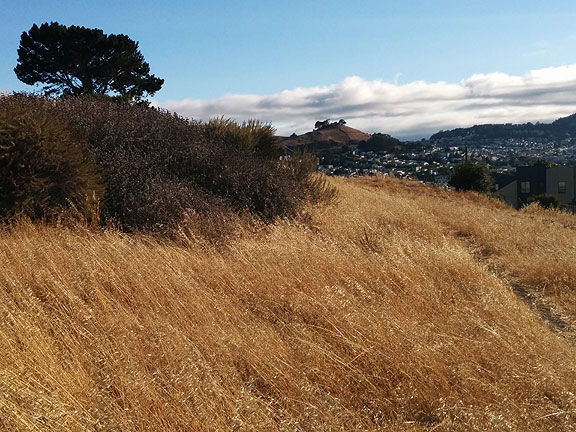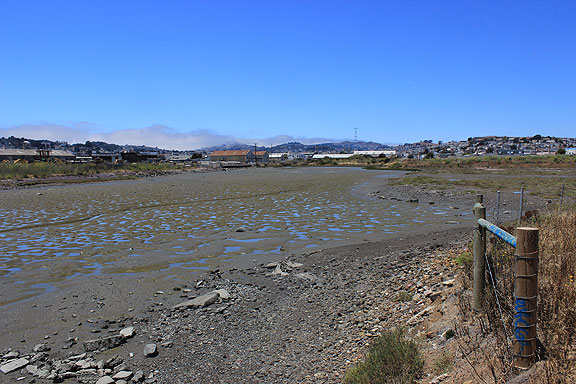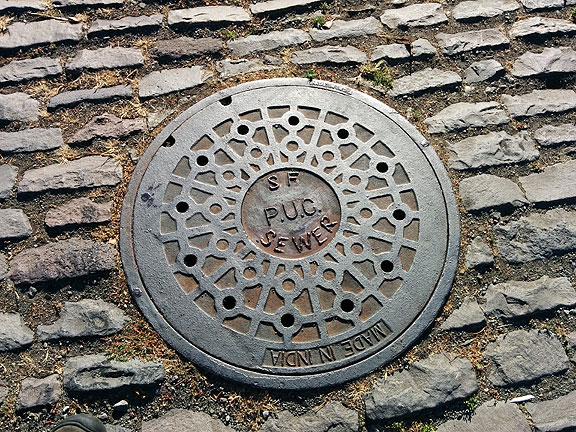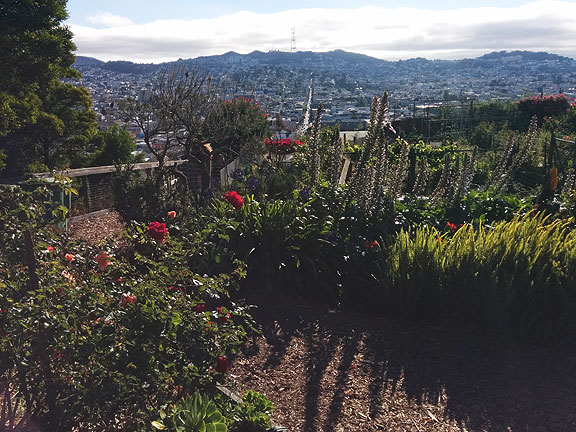
Starr King open space with Bernal Heights in distance behind… one of the gorgeous walks I’ve been on lately.
It’s the middle of July and I have to admit that I’ve let this blog slide considerably from earlier times. I don’t know if anyone is still out there waiting for my writing, but I’m guessing not too many. On the other hand, I’ve had some robot out there try to log on to my account here over 7,500 times in the past five days! I assume that when the Central American child immigrant scandal blew up, some right-wing lunatic got exercised over my most recent blog post about the border. I don’t know who has a robot that just rotates through 16 brand new IPs every hour or so, trying to log on, and I don’t know if this is supposed to be a Denial of Service Attack, or what. A subset of the 101st Fighting Keyboardists I guess (those ardent patriotic intellectuals who fill the comments sections of seemingly every website that has one!)
I’ve been PWOB, Present Without Blogging! Life is full and busy. I take a lot of walks, I’m scurrying about town giving walking and bike tours quite often, and we’ve been pushing our big summer fundraising drive (the 3% solution) for Shaping San Francisco which has gone surprisingly well. That has led me to spending a lot of hours adding new material to the archive at FoundSF.org, including over 200 new early 20th century photos from a private collector. I also confess that I am crazy for World Cup soccer and still a big baseball fan too, so there’s been way too many hours watching sports as well. I also read Dave Zirin’s excellent “Brazil’s Dance with the Devil” (Haymarket Books) which gives an excellent brief history of Brazil, the role of soccer in the country, but more importantly, a no-holds-barred exposé on the role of “celebration capitalism” in using spectacles like the World Cup and Olympics (the latter coming to Rio in 2016) to impose a neoliberal reorganization of urban space. It all benefits existing wealth at the expense of the rest of the population of course, and it’s quite analogous to the “shock doctrine” described by Naomi Klein, though in this case using the spectacle of mass sports to displace and destroy existing networks of life and community.
I read a lot, though not nearly as many hours as I think I should, more books lately but still there’s a steady deluge of magazines arriving in the mail every week. Read that grim piece “The End of Retirement” in the latest Harper’s yesterday, portraying all these over 65 folks too poor to stop working, living in RVs and driving from Amazon warehouse to state park to convention, doing short bursts of temporary (often exhausting) work. I also read Nathan Heller’s “California Screaming” in the July 7 & 14 New Yorker. Much too even-handed for my taste, treating the vicious and often personal tide of displacement and eviction as an unavoidable feature of living in a free society. Glad some friends got recognized and even quoted (Erin McElroy, Tiny, Tommi Avicolla Mecca, even Gabriel Metcalf!), but the author has that galling upper middle class know it all approach that flattens everything out. He insists the “culture war” is overstated, and that “the values that each side espouse can sound strikingly similar.” What I liked about Heller’s piece comes towards the very end. After detailing the various political objections the rich and the techies have against the dysfunctionality of local government, after having shown how dissatisfied activists are with the skewed priorities of local government (which seem to many of us to be focused on taking care of the rich and techies!), he ruminates on the problems of representative public life, but conflates public life with the broken institutions and empty rituals of consultation and deliberation. He argues:
“The West Coast radicalism of the twentieth century arose from the revelation that, in moments of extreme frustration or injustice, power could be claimed and wrongs could be corrected by exiting the system. What started with the dropout hippies and the direct-action campaigns of the sixties reverberates both in the protests of tech’s critics and in the work-arounds, hacks, and philanthropic deliverances of tech itself. The privatized mechanisms of San Francisco politics, with its warring stories of personal good will and subjective transcendence, are the fruits of that heroic nonconformism carried forward. The two groups may not share objectives, yet they’re joined by an escape from public political process that has intensified into local doctrine. The truly radical move in the Bay Area would be to return to the messy business of public debate.
“This would be tricky because public process is antithetical to tech culture. It is not fast. It is unruly and can be dispiriting. There are many people involved, with disparate ideas, and most big decisions are put to public vote—which means more people and ideas. This is the hell of regulatory blockades and referenda and open meetings to which crazy people come to read bizarre complaints off rumpled notebook paper. It is why those hoping for big, swift change leave government, and why people who worry about weak responses stand before buses. Getting anything done through public process requires convincing many, many individuals of the rightness of your dream. And it demands that you do that over and over, against a tide of disagreement, settling for half measures rather than no measures. The terms of public process are not personal or romantic but objective; it is language that could have been drawn up, literally, by committee.”
And then he slides back into middle class complacency, asserting that we have to work to stay “on the same page” and that the deeper political culture will survive the onslaught of “direct action devotees”—that the money will dry up when the Fed stops handing out billions to banks every month and “a company town will move toward becoming, once more, just a town.” Ugh. This trite neoliberal pabulum is hard to take given how profoundly San Francisco’s neighborhoods are being class-cleansed (at least formerly diverse neighborhoods like the Fillmore, the Mission, and South of Market).
On the other hand I think he’s hit the mark when he talks about the break down in public politics. Not precisely in the way he imagines it though. It’s not just that it’s so much work to get lots of individuals to agree with your views, it’s the system is wholly owned and operated by monied interests. The opportunity to comment on or offer critical amendment to public policy is mostly a charade of public hearings that only the most hardy or mentally delusional can bear to attend (or believe are sincere). But it’s also true that we saw the Occupy assemblies hijacked regularly by people who were mentally impaired in various ways. San Francisco has a particularly high percentage of psychotic people living on its streets, and plenty of them are lucid enough to want to occasionally participate in political life—as they should! Who is not troubled sometimes to the edge of sanity by this mad world, after all?
San Francisco is a popular topic these days, thanks to the intrepid friends who blockaded the tech buses last year. Since then international media have been covering the explosion of conflict in San Francisco with a combination of fascination and schadenfreude. Even I wrote a piece in the most recent BOOM: A Journal of California (on the theme of “What’s the Matter with San Francisco?”) summarizing the last half-century’s history of social contestation over development in San Francisco. Hell, our work in Processed World from 1981-94 just got a nice write-up in the latest issue of The Baffler, which helped link the current conversation about tech work and culture and economy to our scathing “tales of toil,” harsh satires, and deep analyses published before the web, when we had only 5 1/4″ diskettes and a text-based email.
This summer, I’m preparing for a new class I’ll be teaching at SFAI this fall called “Dredge”—an odd name for a class. It was chosen by a friend who got another gig which made it available for me to take over. So I’m reading about water, California’s rivers, dredging, wetlands and tidal lands, etc. I know a fair amount about these features in San Francisco’s landscape (historical and contemporary) but I’ve been expanding my research to the whole state.

Yosemite Creek mudflats at low tide, one of the latest restoration projects going on along the southeastern bayshore in San Francisco…
I just finished reading Robert Kelley’s “Battling the Inland Sea” which is a great history of how the Sacramento River and its many tributaries were hemmed in and canalized and eventually brought under “control”—though it is a limited control that can and will break down as it has repeatedly through the past 100 years. Kelley offers a political history of the process as much as a technical account of how the California State Water Project was designed and built. Mining and agricultural capitalists took most of the 19th century to pummel each other into an empty stalemate, with the mine owners holding the upper hand until the mid-1880s, the “farmers” gaining more power after that (farmers is a misleading noun to describe the big landowners on whose property most of the state’s abundant food was grown). The author makes an interesting political argument in the course of his analysis, presenting the Democrats as laissez-faire, anti-government populists in favor of a “Jeffersonian” localism, and the “Whig/Republican” sensibility as the centralizing, paternalistic sensibility of WASP monied interests—businessmen who were enthusiastic about the using the power of government to help private profit.
By this logic, when the Progressive Republicans took over California under the new governor Hiram Johnson in 1911, they set in motion a wide range of reforms (including women’s suffrage, banning of child labor, regulation of public resources, and more) among which was the California State Water Project run by an appointed commission. This finally broke with a half century of hyper-local, private property-based efforts to build levees and control annual flooding on the Sacramento River and its tributaries. In spite of some broken levees and flooding in a few bad years, the system of dams, levees, channels and canals, weirs, seepage ditches, drainage pumping plants that were largely finished by the mid-1940s have suppressed the “inland sea” that annual flooding brought forth in the Sacramento Valley. For decades urban growth and modern life have slowly crept across the former flood plains and tule swamps of the rivers, thanks to this water management infrastructure.
Next up on this thread: “The Tule Breakers” by and about the big dredging firms and the equipment they used to alter California’s hydrology.
My recent reading has also taken me on an interesting tangent into deep history. I read “The Eternal Frontier” by Tim Flannery, a very well written and concise history of the long history of North America since the Chicxulub meteor hit the Yucatan 65 million years ago. He vividly describes what that impact might have done:
“If the location of the strike was unfortunate for North America, the angle of the blow was nothing short of catastrophic. Seismic studies of the crater indicate that the asteroid made a low swipe from the southeast that—like a golfer’s chip shot—generated tens to hundredds of times more heat than a vertical strike would have done. It literally fried America, the heat generated by the impact reaching 1000 times that provided by the sun. And the result would have been particularly severe within 7000 kilometers of the impact point, an area that effectively covers the continent.
“The atmospheric shock wave must have flattened trees all over North America, creating great piles of timber. There is convincing evidence that the Earth’s atmosphere was then about 10 per cent richer in oxygen than it is today. With oxygen levels at about 23 per cent this was a flammable world—when oxygen comprises 24 percent of the atmosphere, even damp timber will burn. Not surprisingly, evidence has been discovered of vast forest fires following the impact, and a global soot layer has been identified. It appears that much of the northern hemisphere was carbonized by the impact…
“Scientists think that the sea along the southern coast of North America withdrew as it poured into the [5-kilometer deep] crater, only to return a few hours later as an enormous tsunami, or more likely a series of them. Were the waves a kilometer high ‘the largest in the history of the world’ as some claim? Whatever the case, I cannot imagine them as being anything but titanic, devastating all that remained standing in interior North America.”
That’s just in the first pages! Flannery goes on to look at every major epoch in North American history geologically, ecologically, botanically and zoologically. I loved reading it for lots of reasons. I really liked the way it put the drastic planetary changes we’re living through now into a very long context of dramatic upheavals in the relationship between land, sea, and life over many millions of years. It doesn’t try to make the current climate change seem “natural” and in some ways serves as grand exhortation to engage with deeper knowledge, deeper and longer histories, and see our own activities embedded in those other narratives. It was a good complement to “The Sixth Extinction” that I read a few months ago. Next up in this thread: “Scatter, Adapt, and Remember: How Humans Will Survive a Mass Extinction” by Annalee Newitz.

This and other manholes like it are on 24th Street just below Starr King open space where there are still cobblestones!
Using this growing awareness of extinction, British writer George Monbiot published “Feral: Searching for enchantment on the frontiers of rewilding”. He spends a lot of the book in and around Wales and its coast, and one of his main foils is the “Sheepocalypse” that plagues the landscape of his area. Monbiot talks a lot about the fossil record which shows elephants and hippos and bears and lots of large animals in the UK, Europe, and North America until very recently in geological time (less than 10,000 years). He describes how a number of tree species adapted to elephants by reproducing from broken branches and trunks, an unlikely trait to have evolved if they weren’t prone to being knocked over regularly. Monbiot is partly genuinely dismayed at the boredom of modern life, and imagines that the reintroduction of large predators would make a walk to the corner grocery more interesting. Actually I don’t think he’s arguing for that, but rather for leaving larger swaths of land to let nature take its course, which would necessarily lead to habitat for keystone predators, which in turn opens space for other species in related niches. Local conservationists get a fair dose of his ire for their enthusiastic efforts to preserve a few endemic plants in a basically denuded landscape—and for their aggressive “management” of ‘sheepocalyptic’ landscapes to prevent any unwanted bushes or trees from taking root.
In his chapter called “The Conservation Prison” he writes:
“The choice of favored ecosystems in this country and in some other parts of Europe appears arbitrary, guided by impulses which have been neither widely examined nor properly explained. The decisions we have made are historical, cultural and aesthetic, dressed up in the language of science. I would not object to this—the way in which we engage with nature will always be mediated by culture—were it not for the fact that some of the upland habitats we have chosen to conserve seem to me to be almost as dismal, impoverished and lacking in structure or complexity as a parking lot.”
He has stories of his own kayaking in the sea, watching local fisheries decline rapidly, and visiting small patches of wild, untended forest in their remnant locales. It’s an important and provocative argument—how do we begin to imagine a future where other species are not simply “protected” but actually have their own territories where we go at our own peril (or enjoyment, depending on your perspective!). What is a properly ecological practice for self-described conservationists? Should it be a micro-management of species distribution in a given habitat, or should it be to cede territory to natural processes, and let things develop as they will? (Perhaps including that humans first make sure the land or sea to be returned to nature is not horribly contaminated already by industrial waste.)
I’ve had Richard Manning’s “Rewilding the West” on my shelf for a while, so Monbiot made me go hunting for it and it’s rising up my pile again.
Lastly I got a great deep background to the current culture of the San Francisco Police Department by reading Christopher Agee’s excellent “The Streets of San Francisco: Policing and the Creation of a Cosmopolitan Liberal Politics, 1950-72.” This seems extra pertinent as we are coming to grips with the rising tide of police violence and the ever-expanding surveillance state. The overarching history here covers the move from the old-style street-level vice that police were often directly benefiting from, to the rise of the Managerial Growth regime (starting with George Christopher’s mayoralty in 1956) and its reliance on the ostensible effort to “professionalize” the police. This was the period when crime went from the streets to the suites.
Agee’s book does a great job of delving into various episodes that illustrate the transition from a day-to-day moral policing that characterized the SFPD for most of its history, to the more professional (and these days, after the end of his inquiry period to 1972, far more militarized) and bureaucratic law enforcement approach it has now. The Department was run by an old boy network for most of its history, usually led by staunch Irish Catholics who saw the role of the police as one of keeping the women and children safe and preserving the 1950s “American family” norm. When the Beats appeared in North Beach and the Fillmore, the police took it upon themselves to enforce vague vagrancy laws against anyone dressed weirdly or apparently rejecting the expectations of normality:
“Conservatives [held that] vagrancy law served as an invaluable “preventative measure” against disorder. In particular cultural conservatives argued that vagrancy law buttresed the family-oriented social order by empowering police to punish men who refused to accept their wage-earning responsibility. One police officer in Hutchinson, Kansas, for instance, defined a beatnik as a person who “doesn’t like work” and promised “Any man who doesn’t like work is a vagrant and a vagrant goes to jail around here.” In San Francisco, Police Chief Cahill charged that the beats’ threat to the family-oriented citizenship model extended beyond financial considerations. Explaining to a New York City newspaper that the SFPD did not keep separate crime rate statistics for North Beach, Cahill retorted, “Anyway, what do you mean by crime? Don’t you consider leading juveniles into a life like that a crime? That’s the greatest crime you can commit.” Cahill warned that beats were exposing children to “sacrilegious” “quotations” (“The way they talked about Christ!” he exclaimed) and to a bacchanal belief that “anything went” “as far as sex was concerned.” The police, he concluded, had a responsibility “to protect our young people from that.”
Agee details how Catholic Action played an important role not just in moral panics like against the beats, but also were at the heart of the redevelopment process too. Turns out that Chester MacPhee, who was elected Supervisor in 1945 as part of the same clean-government wave that also brought in future mayor George Christopher, was the chief customs collector for the Port of San Francisco in the mid-1950s. (Evidently this job came to him AFTER he was fired from being new Mayor Christopher’s Chief Administrative Officer when it was learned that his real estate firm had been involved in the aggressive purchase of over 40 properties ahead of the Redevelopment plans in the Western Addition, then gaming the eminent domain buyouts for instant profits.) As customs collector he fought obscenity by confiscating popular publications that had dirty words or photos of nude men and women on the same page. His weekly prayer sessions in his office made it clear to subordinates the religious rules he was driven by. And it was MacPhee who impounded Allen Ginsberg’s “Howl and Other Poems” and led to the landmark obscenity case that ultimately liberalized obscenity rules when MacPhee was overruled by the U.S. Attorney’s office in 1957.
Agee’s book goes on to show how a new “cosmopolitan liberalism” was vying for power with the old-guard Catholic conservatism, ultimately prevailing as the tide turned in the late 1950s and early 1960s toward more permissive public moral standards. During this time topless nude dancing began in North Beach and explicitly sexual writings gained protection (Lenore Kandel’s “The Love Book” being another big test case that the conservative Catholic hierarchy lost.) By the time Joe Alioto is elected Mayor in 1967, a new liberal coalition based on big capital and big labor and racial inclusion and tolerance is being forged, putting the police in a new role in urban life. No longer are rank-and-file police tasked with enforcing moral standards based on nuclear family norms, but a deeply racist white police culture defends itself by adopting some of the same strategies they’d been undone by—the Police Officers Association becomes the seat of power in the Department as the power of the Catholic Chief wanes.
Agee’s book is really an important contribution to understanding the fraught history of policing, from its day-to-day low level criminality and moralizing in the old days, to its militarized dependence on racial profiling and heavy violence today. The “professionalization” of policing that has been induced by federal drug war policies and subsidies (including a great deal of surplus military hardware in the past few decades) has made police an alien occupation force, far removed from the days of officers walking the neighborhood, taking payoffs from various bars and local criminals, and having a lot of discretion about how and when to enforce vague laws to enforce “normal” standards. But individual police still can and do interpret situations through the lens of their own moral judgment, a lens often colored by racist, homophobic, and other prejudicial assumptions. The blatant police murder of Alex Nieto is an ongoing case in point.














Fine stuff – the essays are always vivid, the photos illuminating.
The Newitz book seems Wired-magazine level boosterism – the one-star reviews – one of the two or three innovations of the Internet I’ve had any use for – on her book are pretty damning. The near-term fate of humanity is damned compelling subject, but do we need more happy technofix journalism?